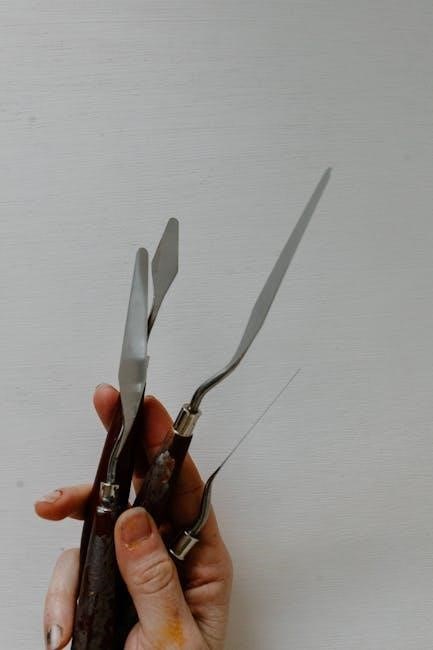A slide-out manual crank handle is a vital tool for RV maintenance, enabling manual operation of slide-outs during power or mechanical failures, ensuring functionality and convenience.
1.1 Definition and Purpose
A slide-out manual crank handle is a mechanical tool designed to operate RV slide-outs when electric systems fail. Its primary purpose is to provide a reliable backup solution, ensuring users can extend or retract slide-outs manually. This essential component is typically used in emergencies, such as power outages or motor malfunctions, to maintain functionality and access to living spaces. The crank handle works by converting manual effort into rotational motion, engaging the slide-out mechanism directly. Its design ensures convenience and safety, allowing RV owners to manage slide-outs without relying on electricity. This tool is indispensable for maintaining comfort and accessibility in RVs, especially during travel or off-grid situations.
1.2 Importance in RV Maintenance
The slide-out manual crank handle plays a crucial role in RV maintenance by serving as a reliable backup solution for operating slide-outs during electrical or mechanical failures. It ensures that RV owners can extend or retract slide-outs manually, maintaining functionality and access to living spaces. This tool is essential for preventing system strain and potential damage to the slide-out mechanism. By providing a manual override option, it helps avoid costly repairs and ensures safety during emergencies. Regular maintenance of the crank handle is vital to guarantee its effectiveness when needed. Its importance lies in its ability to provide peace of mind for RV owners, ensuring their comfort and convenience are not compromised, even in unexpected situations.

Components of a Slide-Out Manual Crank Handle
The manual crank handle system includes a durable crank handle, an extension rod, and a crank tool, designed to work together for smooth slide-out operation.
2.1 The Crank Handle
The crank handle is the primary component used to manually operate the slide-out system. It is typically made of durable materials like steel or aluminum, ensuring strength and reliability. Designed with a comfortable grip, it allows users to apply the necessary torque for smooth operation. The handle is usually detachable for easy storage and features a notch or socket to fit onto the actuator rod. Some models come with ergonomic designs to reduce fatigue during use. Proper alignment and secure fitting are crucial for effective operation, as outlined in various RV maintenance guides and forums. Regular inspection and maintenance of the crank handle are recommended to ensure optimal performance and longevity.
2.2 The Extension Rod
The extension rod is a crucial accessory for the manual crank handle, designed to provide additional reach and leverage when operating the slide-out system. Typically made of durable materials like steel, it is adjustable in length to accommodate various RV models and slide-out configurations. The extension rod connects to the crank handle on one end and attaches to the actuator rod on the other, enabling smooth and efficient operation. It is particularly useful for accessing the slide-out mechanism in hard-to-reach areas, such as underneath the RV or behind panels. Proper alignment and secure connection are essential to avoid damage or malfunction. Regular inspection of the extension rod for wear and tear is recommended to ensure reliability and longevity. Storing it in a dry, secure location when not in use helps maintain its condition.
2.3 The Crank Tool
The crank tool is an essential component of the slide-out manual crank handle system, designed to facilitate smooth and controlled operation; It typically features a comfortable grip and a robust construction, ensuring durability and ease of use. The tool connects to the extension rod and is used to manually turn the mechanism, converting rotary motion into linear movement for extending or retracting the slide-out. Some models may include a universal joint for better flexibility, while others offer adjustable handles to suit different user preferences. Proper maintenance, such as lubricating moving parts and storing the tool securely, is vital to preserve its functionality. The crank tool is often included with the RV or available as an aftermarket accessory, making it a convenient solution for manual slide-out operation.

Mechanism Behind the Slide-Out System
The slide-out system relies on a slider-crank linkage, converting rotary motion from the crank handle into linear movement, enabling smooth extension and retraction of the RV slide-out.
3.1 Slider-Crank Linkage Explained
A slider-crank linkage is a four-link mechanism designed to convert rotary motion into linear motion. It consists of three revolute joints and one prismatic joint, enabling the conversion of rotational input from the crank handle into reciprocating motion. This mechanism is widely used in engines and pumps, where precise control over motion is essential. In the context of RV slide-outs, the slider-crank linkage plays a crucial role by translating the manual rotation of the crank handle into the linear movement required to extend or retract the slide-out room. The linkage ensures smooth and efficient operation, making it a cornerstone of the slide-out system’s functionality. Understanding this mechanism is key to appreciating how manual cranks enable reliable slide-out operation, even in the absence of electric power.
3.2 How the Crank Converts Rotary Motion
The manual crank handle converts rotary motion into linear movement through a series of mechanical components. When the crank is turned, its rotational force is transferred to an extension rod, which connects to the slide-out mechanism. This rod engages with the actuator rod, a key component of the slide-out system, to push or pull the room in or out. The crank’s circular motion is transformed into the straight-line motion required to move the slide-out. This conversion is essential for manual operation, allowing users to control the slide-out’s position precisely, even without electric power. The system relies on the crank’s ability to amplify torque, making it easier to move heavy slide-outs smoothly and efficiently.

3.3 Role of the Actuator Rod
The actuator rod plays a central role in the slide-out system, serving as the direct link between the manual crank handle and the slide-out mechanism. It translates the linear motion generated by the crank into the movement required to extend or retract the slide-out room. When the crank is turned, the extension rod connects to the actuator rod, which then pushes or pulls the slide-out unit along its track. The actuator rod ensures smooth and precise operation, allowing the slide-out to move evenly and align properly. In electric systems, the actuator rod is typically powered by a motor, but in manual mode, it relies on the mechanical input from the crank handle. Its durability and alignment are crucial for the overall functionality of the slide-out system, ensuring stability and structural integrity during operation.

Locating the Manual Crank on Different RV Models
The manual crank’s location varies by RV model and manufacturer but is often found near the slide-out mechanism, under the unit, or via an access panel.
4.1 Jayco Models
In Jayco RV models, the manual crank for slide-outs is typically located near the slide-out mechanism, often accessible through an underbelly access panel or near the frame rails. For specific models like the Jayco North Point or Whitehawk, owners have reported finding the crank handle location on the opposite side of the slide-out or near the pinion shaft. Some models may require removing a panel or accessing the area between the frame rails to locate the manual override. Jayco manuals often provide detailed diagrams, but if unsure, consulting the owner’s manual or contacting Jayco customer support is recommended. Always ensure the RV is stable and on level ground before attempting manual operation.
4.2 Heartland Models
In Heartland RV models, such as the Wilderness and Bighorn series, the manual crank for slide-outs is often located near the slide-out motor or gearbox. Owners have reported accessing it through the underbelly or by removing interior panels. For some Heartland models, the crank may be on the opposite side of the slide-out mechanism, requiring careful alignment with the actuator rod. It’s essential to consult the specific model’s manual or contact Heartland support for precise locations, as positions can vary. Ensure the RV is stable before attempting manual operation to avoid damage or injury.
4.3 Forest River Models
In Forest River RVs, such as the Grey Wolf and Laredo series, the manual crank handle for slide-outs is typically located near the slide-out mechanism. Owners have reported accessing it through the underbelly or by removing interior panels. For some models, the crank may be positioned on the opposite side of the slide-out, requiring alignment with the actuator rod. It’s crucial to consult the specific model’s manual or contact Forest River support for exact locations, as positions can vary. Always ensure the RV is stable and level before attempting manual operation to avoid damage or injury. Proper alignment and gentle handling are key to effective use.
4.4 Other Popular Brands
For other brands like Terry Travel Trailer and Coachmen RVs, the manual crank handle is often concealed for aesthetics but accessible with specific steps. Owners of older models, such as the 1995 Terry Travel Trailer, may need to locate the crank near the slide-out mechanism or behind interior panels. In some cases, accessing the underbelly or frame rails is necessary. Brands like Bighorn and Wilderness by Heartland sometimes position the crank on the opposing side of the slide-out, requiring careful alignment. It’s advisable to refer to the owner’s manual or contact customer support for precise locations, as they can vary widely between models and brands. Ensuring the RV is stable and level is essential before attempting manual operation to prevent damage or injury.

Installation and Maintenance
installing a manual crank handle involves aligning components securely. Regular maintenance includes lubricating moving parts and checking for wear. Use a drill with the correct adapter for smooth operation.
5.1 Steps to Install a Manual Crank Handle
Installing a manual crank handle begins with locating the access point, often near the slide-out mechanism. Remove any protective covers and align the crank with the actuator rod. Attach the extension rod to the handle, ensuring a secure connection. Insert the crank into the access hole, engaging it with the rod. Tighten any locking mechanisms to prevent slippage. Finally, test the crank by turning it clockwise to retract the slide-out. Ensure all parts are properly aligned and lubricated for smooth operation. Always refer to the manufacturer’s instructions for specific details, as models may vary. Proper installation ensures reliable manual operation during emergencies.
5.2 Regular Maintenance Tips
Regular maintenance is crucial to ensure the longevity and functionality of your slide-out manual crank handle. Start by lubricating all moving parts, including the crank and extension rod, to reduce friction and prevent rust. Clean the mechanism regularly to remove dirt and debris that could hinder smooth operation. Inspect the crank handle and rod for signs of wear or damage, replacing any worn components promptly. Store the crank in a dry, protected area when not in use to avoid corrosion. Additionally, check the alignment of the crank and actuator rod to ensure proper engagement. By following these tips, you can maintain the reliability of your manual crank handle and prevent potential issues during operation.
5.3 Troubleshooting Common Issues
Common issues with slide-out manual crank handles often stem from improper alignment, lack of lubrication, or mechanical wear. If the slide-out fails to move, check for debris or dirt in the mechanism and clean it thoroughly. Lubricate the crank and extension rod to ensure smooth operation. If the crank handle does not turn easily, inspect for rust or corrosion and apply a rust-inhibiting spray. For misalignment issues, adjust the crank tool to fit securely onto the actuator rod. If the slide-out still does not function, verify that the actuator rod is properly engaged and consider consulting a professional. Regular maintenance can prevent many of these issues, ensuring reliable operation when needed.

Using the Manual Crank Handle
Connect the manual override crank tool to the extension rod, ensuring proper alignment. Turn the crank handle clockwise to retract or extend the slide-out smoothly and safely.
6.1 Step-by-Step Guide
To use the manual crank handle effectively, start by locating the access point for the slide-out system, often near the base or underside of the slide-out. Insert the crank tool into the designated socket or rod, ensuring it fits securely. Next, begin turning the crank handle clockwise to retract the slide-out or counterclockwise to extend it, applying steady pressure. Monitor the slide-out’s movement to avoid overextension or misalignment. If resistance is felt, stop immediately to check for obstructions. Once the slide-out is in the desired position, secure it with locking mechanisms to prevent unintended movement. Always ensure the RV is on level ground and the area around the slide-out is clear before operating.
6.2 Safety Precautions
When using a slide-out manual crank handle, ensure the RV is on level ground to maintain stability. Always clear the area around the slide-out to prevent accidents or damage. Avoid overexertion, as manual cranking can be physically demanding. Ensure the crank is securely attached to the actuator rod to prevent slippage or injury; Never allow children or pets near the slide-out while operating it manually. Monitor the slide-out’s movement closely to avoid misalignment or overextension. If unusual resistance is encountered, stop immediately and inspect for obstructions or damage. Wear gloves to protect your hands from friction and potential sharp edges. Never force the crank beyond its natural range of motion, as this could damage the mechanism. Always follow the manufacturer’s guidelines for safe operation.
6.3 Tips for Effective Use
For effective use of the slide-out manual crank handle, ensure the crank is securely attached to the actuator rod to maintain control. Apply steady, consistent force while turning the handle to avoid jerky movements. If resistance is felt, inspect the slide-out for obstructions or debris. Lubricate the actuator rod periodically to reduce friction and ease operation. Store the crank handle in an accessible location to ensure quick access during emergencies. Practice using the crank handle beforehand to familiarize yourself with its operation. Use a drill with the correct adapter if equipped, but avoid excessive speed to maintain control. Keep the area around the slide-out clear to allow smooth extension and retraction. Regularly inspect the crank handle and rod for wear or damage and replace them as needed. This ensures reliable performance and prevents unexpected failures. Always refer to the manufacturer’s instructions for specific guidance tailored to your RV model.

Comparison with Electric Slide-Out Systems
Manual crank handles offer simplicity and reliability without electricity, while electric systems provide convenience and faster operation, though they may fail during power outages.
7.1 Pros and Cons
Manual crank handles are reliable during power failures but require physical effort and time. They are cost-effective and durable, ensuring functionality without electricity. Electric systems, while convenient and faster, depend on power and can malfunction. Manual systems are ideal for emergencies but may be less practical for frequent use. Electric slide-outs offer smooth operation but may fail without power, highlighting the importance of manual options as backups. Both systems have their advantages and disadvantages, catering to different user preferences and needs. Choosing between them depends on priority: convenience or reliability in critical situations.
7.2 Reliability and Durability
Manual crank handles are known for their reliability in emergencies, offering a mechanical backup when electric systems fail. Their simple design ensures durability, with fewer components prone to malfunction. Electric slide-outs, while convenient, can experience mechanical failures, making manual systems a dependable alternative. Users often praise the longevity of manual cranks, as they withstand harsh conditions and require minimal maintenance. However, their operation demands physical effort, which can be a drawback. Electric systems, though faster, rely on power and complex mechanisms, making them less durable in critical situations. Overall, manual crank handles are a robust solution for RV slide-outs, ensuring functionality when reliability is crucial.
7.3 Cost and Maintenance Differences
Manual crank handles are generally more cost-effective than electric slide-out systems, requiring minimal upfront investment and maintenance. They lack complex electronics, reducing repair costs and extending longevity. Electric systems, while convenient, involve higher installation and maintenance expenses due to their reliance on motors and power sources. Manual systems are less prone to mechanical failures, lowering long-term expenditure. However, manual operation demands physical effort, which may be a disadvantage for some users. Electric systems, though more expensive, offer ease of use and faster operation. Overall, manual crank handles provide a budget-friendly, low-maintenance alternative, while electric systems cater to those prioritizing convenience and speed, despite higher costs and maintenance needs.

Emergency Situations
Manual crank handles serve as a reliable backup in emergencies like power failures or mechanical breakdowns, allowing RV owners to operate slide-outs safely and effectively without electricity.
8.1 Manual Override in Case of Power Failure
In the event of a power failure, the manual override feature of the slide-out system ensures functionality. To activate it, locate the access hole for the manual crank, typically found near the slide-out mechanism or under the RV. Insert the crank tool into the access hole and attach it securely to the actuator rod. Turn the crank handle clockwise to retract the slide-out or counterclockwise to extend it. This process allows you to control the slide-out manually, providing a reliable solution when electric systems fail. Always ensure the area is clear of obstacles and maintain a steady, firm grip on the crank handle for smooth operation. Regular practice of this procedure can help prevent issues during emergencies.
8.2 Resetting the Slide-Out System
Resetting the slide-out system is crucial after a malfunction or power failure. Begin by ensuring the slide-out is fully retracted using the manual crank handle. Next, disconnect the power supply to the system to prevent accidental activation. Locate the reset button or switch, typically found near the control panel or motor assembly. Press and hold the reset button for 10-15 seconds to reset the internal mechanisms. Reconnect the power supply and test the slide-out operation. If issues persist, consult the user manual or contact a professional technician. Regular resets can help maintain system functionality and prevent future malfunctions.
8.3 Common Emergencies and Solutions
Common emergencies with slide-out systems include mechanical failures, power outages, or system misalignment. In such cases, the manual crank handle serves as an essential backup solution. Start by locating the access point for the crank handle, often near the slide-out mechanism or under the RV. Insert the handle into the designated socket and rotate it clockwise to retract or counterclockwise to extend the slide-out. If the slide-out is misaligned, ensure it is manually guided back into place. For stuck slides, apply a small amount of lubricant to moving parts and gently operate the crank. Always refer to the user manual for specific instructions tailored to your RV model. Regular maintenance can prevent many of these issues, ensuring smooth operation and reliability.
The slide-out manual crank handle is an indispensable tool for RV owners, providing reliability and control during emergencies, ensuring smooth operation and peace of mind for years to come.
9.1 Summary of Key Points
The slide-out manual crank handle is an essential tool for RV maintenance, offering a reliable solution during power or mechanical failures. It provides precise control over slide-out systems, ensuring smooth operation even in emergencies. Regular maintenance and proper installation are crucial for optimal functionality. Understanding the mechanism, including the slider-crank linkage and actuator rod, enhances user efficiency. Locating the crank handle varies by RV model, with brands like Jayco, Heartland, and Forest River having specific access points. Using the handle correctly, with safety precautions, prolongs system durability. Compared to electric systems, manual cranks offer simplicity and cost-effectiveness. In emergencies, the manual override ensures continued functionality, making it a vital component for RV owners seeking convenience and reliability.
9.2 Final Thoughts
The slide-out manual crank handle is a dependable backup solution for RV slide-out systems, ensuring functionality during power or mechanical failures. Its simplicity and reliability make it a cost-effective alternative to electric systems, offering peace of mind to RV owners; Proper maintenance and understanding of its operation are key to maximizing its benefits. While electric systems may offer convenience, the manual crank handle remains a practical and essential tool for emergencies. For RV enthusiasts, it is a must-have accessory that combines durability with ease of use, ensuring uninterrupted enjoyment of their travels. Its importance cannot be overstated, making it a cornerstone of RV maintenance and preparedness.

Additional Resources
For further guidance, explore manufacturer websites, repair guides, and RV forums. Tools like Google Lens can help identify parts, while advanced search tips enhance troubleshooting efficiency online.
10.1 Recommended Tools and Accessories
Essential tools for slide-out maintenance include a manual crank handle, extension rods, and a crank tool. These components ensure smooth operation and are readily available at retailers like Walmart. Additional accessories such as lubricants and repair kits can extend the lifespan of your slide-out system. Online resources and forums provide detailed guides on selecting the right tools, while advanced search techniques help locate specific parts efficiently. Properly equipping yourself with these resources and tools ensures you’re prepared for any situation, whether routine maintenance or emergency repairs. Always refer to manufacturer guidelines for compatibility and safety.
10.2 Further Reading and Guides
For comprehensive understanding, explore official manufacturer manuals and online forums like RV enthusiast communities. Video tutorials on YouTube offer step-by-step guidance for DIY repairs. Detailed articles on RV lifestyle blogs provide practical insights, while technical guides from RV repair services ensure professional advice. Utilize these resources to enhance your knowledge and troubleshooting skills, ensuring optimal performance of your slide-out system.
